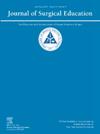EHR-Driven Delivery of EPA Assessments Significantly Improves Participation
IF 2.6
3区 医学
Q1 EDUCATION, SCIENTIFIC DISCIPLINES
引用次数: 0
Abstract
INTRODUCTION
Digital education tools are a cornerstone in the evolution to CBME through EPAs. Successful implementation requires understanding the variable impacts of EHR-driven delivery of EPAs, flexible digital device access to EPAs, and user-behavior trends.
METHODS
Through a HIPAA compliant, flexible-device accessible, surgical education platform, general surgery training programs at 21 institutions collected EPA from July 2023 to April 2024. At 5 EHR-integrated institutions (EHR+), EPA were created for clinical activities based on the OR schedule, automatically pushed to attendings and residents with built in completion reminders. At 16 institutions without EHR integration (EHR-), EPA were initiated manually. To improve user experience, care phases were bundled (cEPA). We compared the EHR+ and EHR− groups, computing descriptive statistics on the cEPAs completed and user behavior metrics.
RESULTS
We collected 4187 cEPAs in total, with 82% at EHR+ institutions and 18% at EHR- institutions. Platform triggering dramatically drove cEPA completion for both faculty and residents, 88% and 81%, respectively. Only 3% were initiated by the faculty or resident. Faculty at EHR+ institutions strongly preferred the automated OR-triggered workflow to start their EPAs (Chi-squared test, p ≈ 0). Faculty completed all 3 care phases nearly 80% of the time. Time reminders specifically drive EPA completion for residents and faculty on weekdays and build habits on weekends. 71% of cEPAs completed were by computer, and 29% by phone. More comments were provided when computers were used. Residents reviewed feedback with a median lag of 1 hour and 29 min after results were available.
CONCLUSIONS
EHR-driven delivery of EPA leads to a 4.6-fold increase in EPAs completed. EPA initiation is the most critical phase in the workflow and EHR-data driven alerts drive this action. These alerts are also effective drivers of habit formation. Flexible device access is important to increase EPAs completed and improve the usefulness through comments for residents.
电子病历驱动的 EPA 评估大大提高了参与度。
导言:数字教育工具是通过 EPA 向 CBME 演进的基石。成功实施需要了解电子病历驱动的 EPAs 交付、灵活的数字设备访问 EPAs 以及用户行为趋势的不同影响:通过一个符合 HIPAA 标准、可通过灵活设备访问的外科教育平台,21 家机构的普通外科培训项目收集了 2023 年 7 月至 2024 年 4 月期间的 EPA。在5家整合了电子病历的机构(EHR+),根据手术室日程表为临床活动创建了EPA,并自动推送给主治医师和住院医师,同时内置了完成提醒功能。在 16 家未整合电子病历的机构(EHR-)中,EPA 是手动启动的。为了改善用户体验,护理阶段被捆绑在一起(cEPA)。我们比较了 EHR+ 组和 EHR- 组,计算了已完成 cEPA 的描述性统计和用户行为指标:我们共收集了 4187 份 cEPA,其中 82% 来自 EHR+ 机构,18% 来自 EHR- 机构。平台触发极大地推动了教师和住院医师的 cEPA 完成率,分别为 88% 和 81%。只有 3% 是由教师或住院医师发起的。EHR+机构的教员更倾向于使用手术室触发的自动化工作流程来启动他们的EPA(卡方检验,P≈0)。近 80% 的教员完成了所有 3 个护理阶段。时间提醒专门推动住院医师和教员在工作日完成 EPA,并在周末培养他们的习惯。71% 的 cEPA 是通过电脑完成的,29% 是通过电话完成的。在使用电脑的情况下,反馈意见更多。住院医师在获得结果后审查反馈意见的中位时滞为 1 小时 29 分钟:结论:电子病历驱动的 EPA 交付使完成的 EPA 增加了 4.6 倍。EPA 启动是工作流程中最关键的阶段,而电子病历数据驱动的警报则推动了这一行动。这些提示也能有效促进习惯的养成。灵活的设备访问对于增加 EPA 的完成率和提高居民意见的实用性非常重要。
本文章由计算机程序翻译,如有差异,请以英文原文为准。
求助全文
约1分钟内获得全文
求助全文
来源期刊

Journal of Surgical Education
EDUCATION, SCIENTIFIC DISCIPLINES-SURGERY
CiteScore
5.60
自引率
10.30%
发文量
261
审稿时长
48 days
期刊介绍:
The Journal of Surgical Education (JSE) is dedicated to advancing the field of surgical education through original research. The journal publishes research articles in all surgical disciplines on topics relative to the education of surgical students, residents, and fellows, as well as practicing surgeons. Our readers look to JSE for timely, innovative research findings from the international surgical education community. As the official journal of the Association of Program Directors in Surgery (APDS), JSE publishes the proceedings of the annual APDS meeting held during Surgery Education Week.
 求助内容:
求助内容: 应助结果提醒方式:
应助结果提醒方式:


